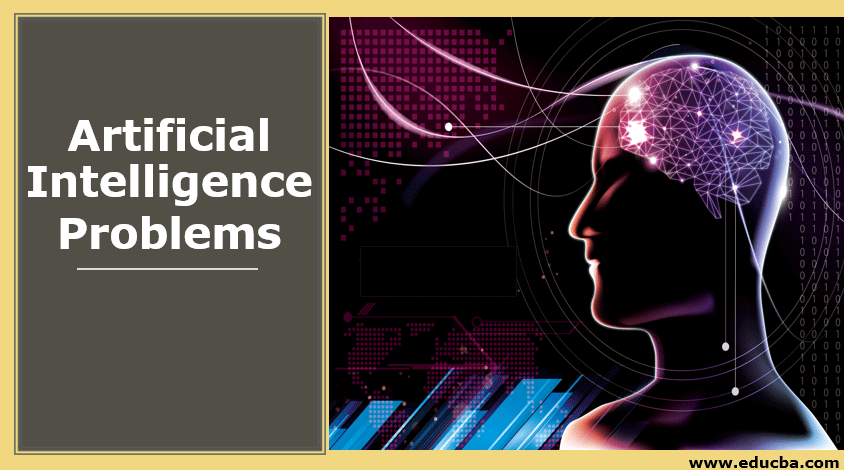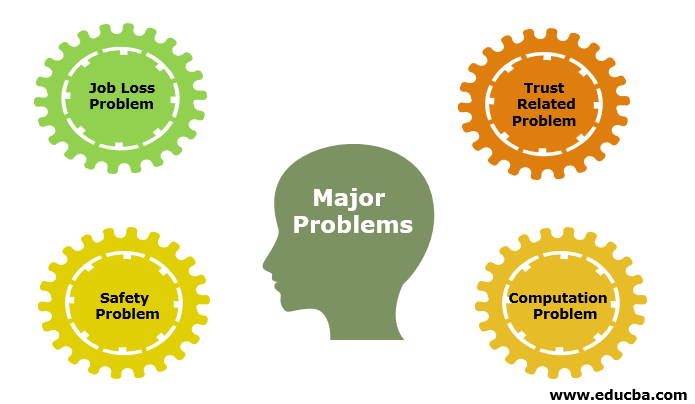Updated May 20, 2023
Overview of Artificial Intelligence Problems
Artificial Intelligence continues to bring incremental benefits to human life. According to the Mckinsey report, Artificial Intelligence projects to contribute $13 trillion to the global economy by 2030, accounting for approximately 16% of the global share. Notwithstanding the tangible and monetary benefits, AI has various shortfall and problems which inhibits its large-scale adoption. The Artificial Intelligence Problems include Safety, Trust, Computation Power, Job Loss concerns, etc.
Major Problems Associated with Artificial Intelligence
The following are a few major problems associated with Artificial Intelligence and its possible solutions.
1. Job Loss Problem
Job loss concerns related to Artificial Intelligence have been the subject of numerous business cases and academic studies. As per an Oxford Study, more than 47% of American jobs will be under threat due to automation by the mid-2030s. According to the World Economic Forum, Artificial Intelligence automation will replace over 75 million jobs by 2022. Some of the figures are even more daunting. According to another Mckinsey report, AI-based robots could replace 30% of the global workforce. As per the AI expert and Venture Capitalist Kai-Fu Lee, 40% of the world’s jobs will be replaced by AI-based bots in the next 10-15 years. Low-income and low-skilled workers will be the worst hit by this change. As AI becomes smarter by the day, even the High paid, High skilled workers become more vulnerable to job losses as, given the high cost of skilled workers, the companies get better margins by automating their work. However, these issues related to Job loss and wages can be addressed by focusing on the following measures.
- Overhauling the education system and giving more focus on skills like Critical Thinking, Creativity, and Innovation, as these skills are hard to replicate.
- To align it with industry demand, we can increase public and private investment in developing human capital.
- Improving the condition of the labor market by bridging the demand-supply gap and giving impetus to the gig economy.
2. Safety Problem
Safety issues associated with Artificial Intelligence have always stirred up a lot of furor. When experts like Elon Musk, Stephen Hawking, and Bill Gates, among others, express concern about AI safety, we should pay heed to its safety issues. Artificial Intelligence has encountered instances where Twitter Chatbot began spewing abusive and Pro-Nazi sentiments, and Facebook AI bots started interacting in an incomprehensible language, resulting in the project’s shutdown.
There are grave concerns about Artificial Intelligence doing something harmful to humankind. A case in point is autonomous weapons which can be programmed to kill other humans. There are also imminent concerns with AI forming a “Mind of their Own” and doesn’t value human life. Deploying such weapons will make undoing their repercussions very difficult. We can take the following measures to mitigate these concerns.
- We need to have strong regulations, especially when it comes to the creation or experimentation of Autonomous weapons
- To ensure that no one gets involved in the rat race, we need global cooperation on issues concerning such kinds of weapons.
- Complete transparency in the system where such technologies have been experimented with is essential to ensure their safe usage
3. Trust-Related Problem
As Artificial Intelligence algorithms become more powerful by the day, it also brings several trust-related issues on their ability to make fair decisions for the betterment of humankind. With AI slowly reaching human-level cognitive abilities, the trust issue becomes all the more significant. There are several applications where AI operates as a black box. For example- in High-Frequency trading, even the Program developers don’t understand the basis on which AI executed the trade. Amazon’s AI-based algorithm for same-day delivery inadvertently exhibited bias against black neighborhoods, providing a striking example. Another example was Correctional Offender Management Profiling for Alternative Sanctions (COMPAS), where the Artificial Intelligence algorithm, while profiling suspects, was biased against the black community.
We can take the following measures to bridge trust-related issues in Artificial Intelligence.
- All the major Artificial Intelligence providers need to set up guiding rules and principles related to trust and transparency in AI implementation. All stakeholders involved in Artificial Intelligence development and usage must religiously follow these principles.
- The stakeholders should be aware of the bias which inherently comes with AI algorithms and should have a robust bias detection mechanism and ways to handle it
- Awareness is another key factor that plays a major role in bridging the trust gap. We should sensitize users about AI operations, its capabilities, and even the shortcomings associated with Artificial Intelligence.
4. Computation Problem
Artificial Intelligence algorithm analyzes the humongous data that require immense computational power. So far, the problem has been dealt with with the help of Cloud Computing and Parallel Processing. However, as the amount of data increases and more complex deep learning algorithm comes into the mainstream, the present-day computational power will not be enough to cater to the complex requirement. We will need more storage and computational power to handle crunching exabytes and Zettabytes of data.
Quantum Computing can address the processing speed problem in the medium to long terms
It is based on Quantum theory concepts that might be the answer to solving computation power challenges. Quantum computing is 100 Million times faster than a normal computer we use at home. Although currently, it is in the research and experimental stage. Experts estimate that we can see its mainstream implementation in the next 10-15 years.
The problems above are certainly not impossible to solve. However, it does require rapid evolution in technology and human cooperation. While we are well on course in terms of the rate of technological advancement but we still have a long way to go to develop principles, methodology, and frameworks to ensure that powerful technology like AI is not misused or misapplied, which may result in unintended consequences.
Recommended Articles
This is a guide to Artificial Intelligence Problems. Here we discuss the basic meaning of major problems associated with Artificial Intelligence AI and its possible solutions. You may also look at the following articles to learn more –





